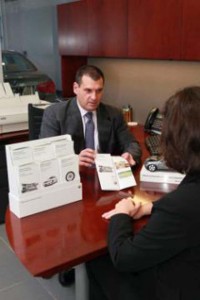
Sign on the dotted line...dealers are seeing a steady increase in traffic, a trend expected to continue in 2013.
The last-minute Congressional compromise that kept the country from going off the so-called fiscal cliff is good news for the U.S. economy and great news for the auto industry, for as the old adage goes: when the economy catches cold the auto industry gets pneumonia.
The resolution in Washington sidestepped some key issues that must yet be worked out in the coming months. But barring some later hitch that generates a new crisis, most industry analysts and insiders are confident that the U.S. car market is finally back on track after its worst downturn since the Great Depression.
A new study by R.L. Polk is forecasting new vehicle registrations will reach 15.3 million in the U.S. this year and “We see it getting into the 16 million range by 2015,” Tom Libby, Polk’s lead analyst for North American forecasting, tells TheDetroitBureau.com.
That would be a roughly 50% increase in 2013 from the bottom of the automotive market collapse during the depths of the downturn, and a 6% to 7% rise from the anticipated final sales numbers for 2012 – which are likely to reach near 14.5 million when year-end figures are reported by the industry tomorrow.
As good as that might sound, the turnaround is still lagging behind prior recoveries. The U.S. auto market reached an all-time high in 2005 of 17.5 million vehicles, a figure Libby – and other analysts – don’t expect the industry to again see “in the near-term.” In fact, few anticipate coming even close to that record before the country enters the next cyclical economic dip.
But few think that matters, either.
“The industry is very different from 2005,” explains Libby, “when there was much greater production capacity that was forcing manufacturers to use a lot larger incentives” to buoy demand and keep factories running. “We saw those years as artificially high.”
In fact, Detroit’s makers were saddled with so much excess capacity that even with sales running at record levels they could barely maintain profitability. By the time the industry was at its 2005 peak General Motors and Chrysler were already accelerating their slide towards the 2009 bankruptcies they survived only with the aid of a massive federal bailout.
The Detroit makers leaned out their operations by closing dozens of assembly and component plants, scaling back wherever possible – and with the help of major concessions from union workers.
With less excess capacity and lower operating costs, automakers don’t need to dangle massive incentives in front of otherwise reluctant buyers. According to data from TrueCar.come, the average rebate and other giveback has fallen substantially over the last 12 months and even more dramatically since the bottom years of 2009 and 2010. At the same time, transaction prices — what customers actually pay for a new vehicle — have been running at or near all-time records.
As a result, says Libby, sales of “15 million to 16 million is very health (and the makers) will see major profits and everyone will be very healthy.”
He and other industry figures warn that things could still fall off the cliff if Congress can’t resolve the remaining fiscal issues later this year. But Libby believes that Americans are “becoming numb” to the sort of posturing and infighting of a gridlocked Congress and that means the panicky headlines are less likely to send potential car buyers into hiding compared to political crises of the past.
That’s why the anticipated sales numbers for December – which will be released on January third – should be among the best for all of 2012 and provide a burst of momentum for the New Year.
